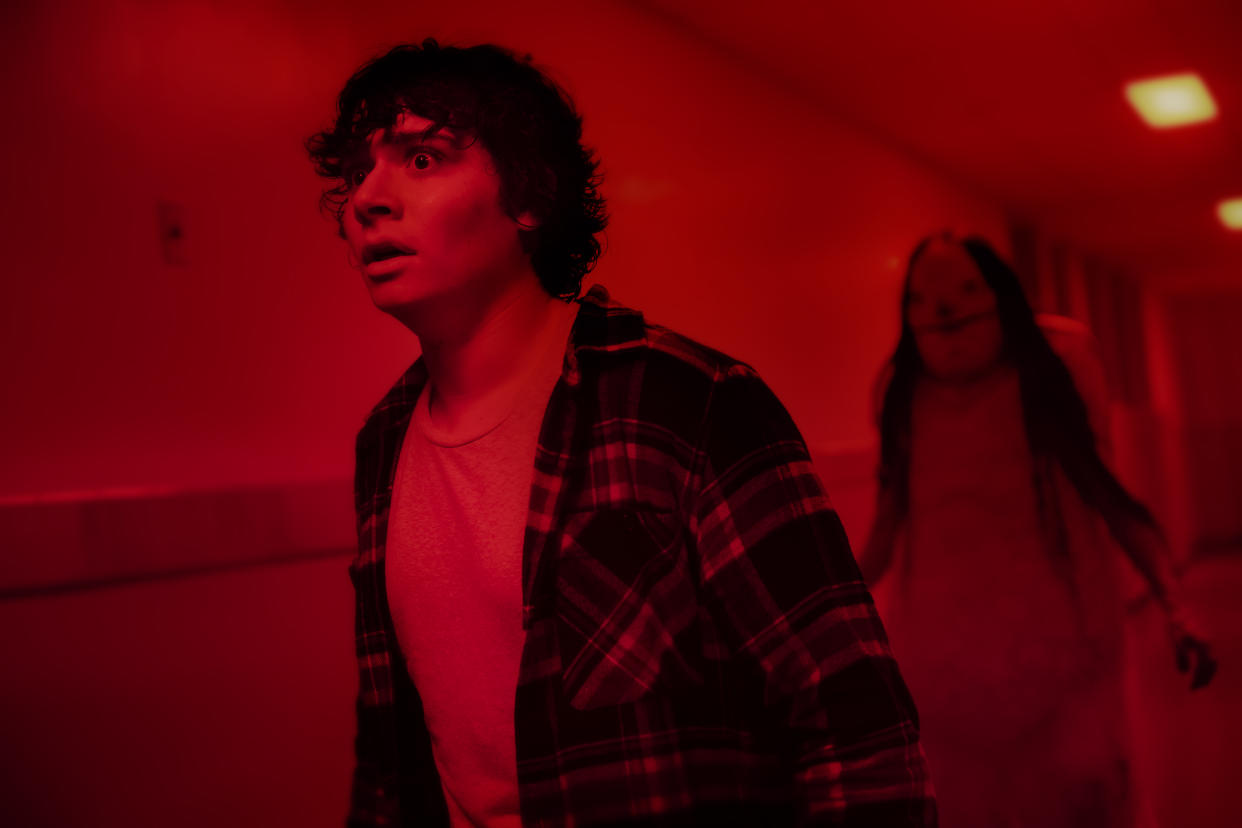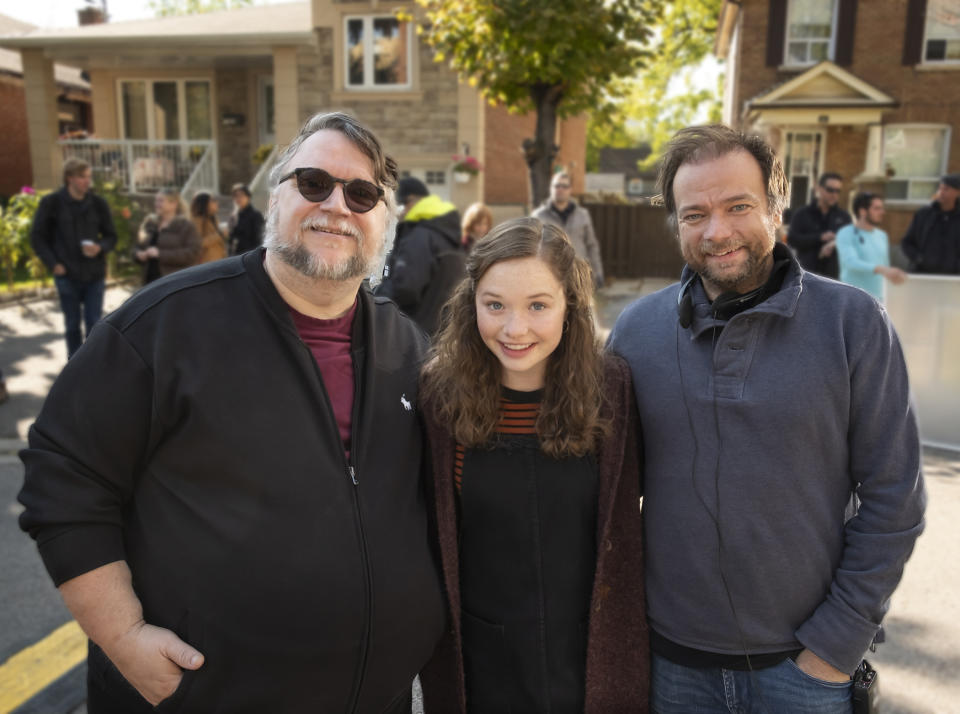Nightmare fuel alert! How the 'Scary Stories' movie brings the Pale Lady to horrifying life

Warning: This post contains spoilers for Scary Stories to Tell in the Dark.
Talk about your trilogies of terror: Alvin Schwartz’s three-volume anthology series, Scary Stories to Tell in the Dark, have been serving up nightmare fuel to generations of kids. Drawing on a wide variety of fear-inducing folk tales and urban legends, the three Scary Stories collections amp up the creepiness factor through Stephen Gammell’s sinister black-and-white illustrations, which leap off the page and into your dreams.
That’s what happened to Oscar-winning filmmaker, Guillermo Del Toro, who discovered the books as an adult, but instantly felt a kinship for the creatures Gammell sketched on the page. One in particular always stood out to him, so much so that he purchased a piece of Gammell’s original artwork that still proudly hangs in his collection. That would be the Pale Lady, who appears in the story, “The Dream,” originally published in the third Scary Stories volume, 1991’s More Tales to Chill Your Bones. “She’s the most striking piece of art in the books,” Del Toro tells Yahoo Entertainment.
It’s no wonder, then, that the Pale Lady is also at the center of the most striking sequence of the long-awaited film version of the Scary Stories series, executive produced by Del Toro and directed by Norwegian genre guru, André ?vredal. Unlike the books, the film tells one overarching story that incorporates new variations on several of Schwartz’s tales, including “The Big Toe,” and “The Red Spot.”
That narrative involves a group of kids in small-town Pennsylvania who stumble upon a leather-bound book in a haunted mansion — a book that pens stories that literally do leap off the page and into the characters’ lives. So one always-hungry boy accidentally gnaws on a big toe that’s been hidden in a pot of stew, while a vain teenage girl watches the red spot on her face erupt into a plethora of spiders. “What we tried to do is ensure that each of the dreams or scary things that happen to the characters is the thing they fear the most,” Del Toro explains.
In the case of the Pale Lady, they connected that grinning ghoul to the fear of... hugging? At least, that’s the thing that most upsets oversensitive teenager Chuck (Austin Zajur), who tells his mother off early in the movie for daring to try and give him a hug. When he has his face-to-face encounter with the Pale Lady later on, she walks slowly and deliberately toward him and wraps him in a warm embrace that has deadly consequences. That’s a substantial change from “The Dream,” where the Pale Lady appears in the dreams of an artist with an unnerving vision of what might happen if she decides to make the journey to a small village. The artist ends up traveling to a different town, but still finds herself entering the same scenario her nighttime visitor showed her. “The original story is about repetition, so we found a way to do that that really worked for our movie,” says ?vredal.

In the film, Chuck has followed his friends into a mental hospital in search of clues to the owner of the book, and winds up racing by himself through a series of basement hallways drenched in blood-red light. Rounding a corner, he sees a pale figure moving in his direction. When he races into a different corridor, he spots her again, still heading towards him. No matter which way he turns, she’s always there... and always getting closer. “It was created to be a specific kind of nightmare,” the director says. Adds Del Toro: “That’s one of the scenes that I look at and go, ‘That’s exactly how it should be.’ I’m a director myself so I can heap praise on André — it’s really cinematic.”
A longtime advocate for practical effects over CGI, Del Toro helped oversee the construction of the Pale Lady creature. “The main challenge was sculptural,” he remembers. “You’re not making a very complex mechanical monster; it’s a paint and sculpting job, and the key to the character is that she looks benign. Her expressions are very minimalistic and creepy, so you have to sculpt the weight, the folds, the smile and the sort of twinkle in the eye. You also have to paint it so she can exist under a red light, but when you have skin that pale, it can become completely white on camera. We used a sort of Memory Foam for the material, so that [Austin] could sink into her chest.”

On set, ?vredal relied on his instinct to gauge how slowly the performer playing the Pale Lady should move to achieve maximum creepiness. “The drawing gave us so much to work from, and we were always adamant about keeping the creature design exactly like the drawing. From then on it was about how she breathes, how she moves, how she talks and how she behaves? We focused in on that, and I was extremely lucky to have Guillermo help me. On one of the days, he was instructing the Pale Lady for some shots, and it was awesome to look at how he saw Pale Lady.”
In the near future, Del Toro will have the chance to see another character from his past come to new life. Having directed Wesley Snipes in 2002’s Blade II, he’s ready for Mahershala Ali to assume the shades when the vampire hunter joins a new phase of the Marvel Cinematic Universe. “I think it’s an amazing choice,” Del Toro raves, echoing Snipes’s own comments. “He looks like the perfect person to do that.”
Scary Stories to Tell in the Dark is playing in theaters now. Visit Fandango or Atom Tickets for showtime and ticket information. The original books can be purchased on Amazon or Barnes & Noble.
Read more from Yahoo Entertainment:
Get spooked out by Guillermo del Toro's terrifying 'Scary Stories to Tell in the Dark' trailer
'The Kitchen' stars reveal why it's time for women to take over mob movies
Want daily pop culture news delivered to your inbox? Sign up here for Yahoo Entertainment & Lifestyle’s newsletter.


